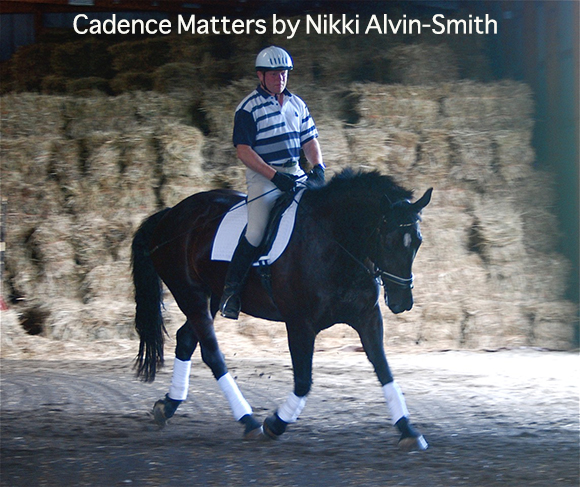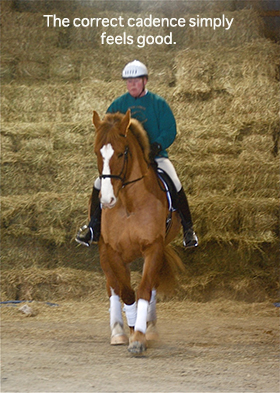Cadence Matters
By Nikki Alvin-Smith

The cadence of your horse’s gaits is important in not just dressage but in many riding disciplines. When I explain what cadence is to a student, I like to refer to it as ‘the horse’s sweet spot.’ For each horse this will be different, and each gait will have its own ‘all important’ cadence that the rider must activate, appreciate and develop as the training of his horse progresses.
Many people mistake cadence for rhythm in horse training, which is not the same thing at all. A horse may move stiffly forward, strung out and flat across his back and down on his shoulders and still move in rhythm. The quality of the gait will therefore naturally be of lesser quality than one where the horse moves with impulsion from behind with engaged core muscles, elevated neck and moving freely toward a soft hand accepting the bit. A horse may rush around but still show rhythm whether his tempo be fast or slow.
To work with cadence you need to have your horse moving forward with impulsion and straightness in his gaits. His shoulders should feel elevated and be free and tractable in your hands and you should be able to position his head down and forward toward the bit showing suppleness across his topline and be able to direct his head to flex either inside or outside with ease off your leg with very little direction from your hands.
When you have attained this stage of training and your horse stays relaxed and can freely maintain this posture with minimal influence from the rider, then you are ready to further investigate cadence.
Cadence is about the posture of your horse and his ability to balance himself. This obviously requires a certain degree of training to attain and as we train our horses we must constantly keep this goal in mind.
The rider must learn to help the horse choose his own’ sweet spot ‘ when riding by having first educated the horse to the requirements above. Then the rider may ask for a little more impulsion in the gait and see where the horse loses his balance. If the horse rushes, stiffens or loses his rhythm then the horse has been pushed too far and the rider must lessen the request. As the horse becomes stronger through correct work the horse will be able to accept the stronger request and maintain his own posture and balance. His gaits will become rounder, more expressive and his body will remain relaxed and joints open to movement.
How many times have you viewed a horse for purchase and heard someone say that the horse hasn’t the best trot but that it will get better with training? This is true. In fact of all three gaits the easiest one to improve with good training is the trot. It will become loftier, rounder and the horse will move lightly on its feet requiring little rein pressure or interference from the rider. The walk and the canter will also be improved in their quality via educated training.
Cadence is extremely important in all dressage exercises. For example, in flying changes the horse may be rocked too far back on his hind end, his neck or gait be too shortened, and he may hesitate in his change pre-empting the movement and thus change late behind or not at all or become disunited in his canter. The quality of the canter and especially its cadence will determine the success of the flying change. When teaching changes always send the horse more forward to prevent this hesitation. While the horse may rush after the change due to a loss of balance he can be taken back to his correct cadence and balance with small half halts on the new outside rein, the better decision would be to improve the cadence of the gait.
If you still have trouble bringing the horse back to his correct cadence in the canter after a change then bring him to a trot and then return to canter.
In the half pass the horse must have cadence in his gait as the lateral movements require a shifting of balance that will quickly indicate a lack of workmanship on the cadence of the gait by becoming uneven, haunches leading, too much neck bend etc. as the rider desperately tries to correct the gait of the horse by some contortion of their own body or overuse of hands and legs. If the rider takes the horse back to cadence work, work that should be a daily goal, then the half pass will improve.
The correct cadence simply feels good. If you run or swim you know that at a certain point you ‘hit your stride.’ You feel as though you can go on forever. Your body is fit and answering the needs you demand without stress or tension. You should feel that you can alter the length and elevation of the stride with ease in a concertina fashion without loss of balance.
You can affect cadence in both the sitting and posting trot. Your horse must be able to maintain his correct frame no matter whether you work on a circle, change bend or direction. Be careful not to overdo the time you spend sitting the trot. Always refresh the gait by interspersing periods of posting trot. You can work during these transitions on maintaining the cadence.

It is very helpful to ride your horse outside when working on cadence as the horse is more animated and more activity comes from his own merit. Constantly seek the regularity in his gaits and the relaxation and the ability for him to gently accept the requests for increased impulsion without falter or rushing.
Many horses are rushed by over-asking for impulsion in their early riding. This rapidly destroys their gaits, especially the walk. A horse will most naturally show his cadence in his walk as this is the gait in which he finds it easiest to balance himself with little rein aid from the rider. If you over-ask for impulsion and hind leg activity your horse may try to give generously to your request but as he may not have the strength yet to answer your demands he may simply hollow his back by a lesser or greater degree. This is to be avoided at all costs. I often tell my students not to be greedy, which is especially important with the horse that gives everything and/or has naturally expressive gaits.
Correct cadence for your horse will be unique to him. This will depend much on his conformation but also on his temperament. For some horses it will be an extravagant stride for others it will be a shorter stride. This also depends on the level of training of the horse and its breed.
Iberian breeds were primarily bred for collection and their backs are generally shorter and tighter. In recent years these breeds have been bred to exhibit larger more extended gaits or showcase more warmblood style and amazingly have migrated very much upward in size from the breed standards. These facts are abhorred by the true breeders but welcomed by the competitive rider. These breeds will find cadence easier to attain but it will be hard to take this cadence into the next stage of extension.
The Thoroughbred type horse will always operate with more tension and stiffness by his design and temperament. He may take more patience to train and require more gymnastic work to attain this level of natural gait and posture. For the hotter horse in general this relaxation and cadence and regularity is especially important as it allows them to learn and to become confident in themselves.
The warmblood breeds will generally appear to attain this balance and posture more easily, but in fact as there is just so much more of them to organize they can easily be spoiled and over pushed. The rider must be extremely diligent not to be greedy and request too much too soon of the big gaited movers as the rider may find it harder to tell when they are asking too much and when it is just enough.
Friesian horses are also Baroque horses and they may have a tendency to tighten in their backs especially in the canter and not truly be over their backs although they may appear to be maintaining the posture. Horses with naturally elevated and expressive gaits may ‘fake’ cadence if the rider is not educated and an experienced trainer can address this issue and thus will promptly solve issues with movements between 3rd/4th levels to FEI.
Any type of rushing of gaits creates tension and horses cannot learn in tension and tension destroys joints and creates soundness issues. At the top levels of the sport you will hear riders say that some tension is good. That they want that elevated level of ‘buzz.’ This is a point on which classicists would argue with the score driven competition rider/trainer. What is rewarded in the ring may or may not be classical dressage at any point in time. For myself I have always found that the atmosphere at competition venues combined with some nervousness from both my horse and myself is quite enough tension on its own to create that little extra ‘buzz.’
A horse that is in tension will tire quickly, as indeed will a rider. When teaching I am always gratified to see a rider ‘get it’ as cadence is such an important factor in the well-being of both horse and thus rider. As we all know riding a tense horse can make us sore and tense too. The horse’s eye will relax knowingly and seemingly grow softer with happiness, comfort and understanding. The horse moves effortlessly and with pride and in great beauty. The rider feels the same way and will dismount grinning from ear to ear. Your horse will thank-you for taking the time to educate yourself on his behalf and constantly seek this ‘sweet spot.’


